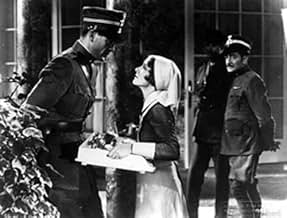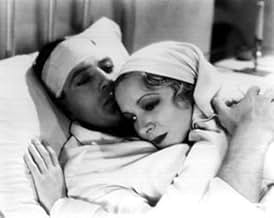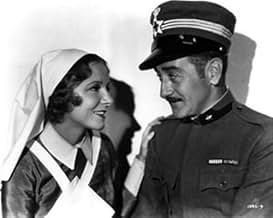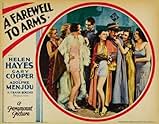Segui questa storia romantica e stimolante di un autista di ambulanze americano e un'infermiera inglese che si innamora in Italia durante la prima guerra mondiale.Segui questa storia romantica e stimolante di un autista di ambulanze americano e un'infermiera inglese che si innamora in Italia durante la prima guerra mondiale.Segui questa storia romantica e stimolante di un autista di ambulanze americano e un'infermiera inglese che si innamora in Italia durante la prima guerra mondiale.
- Regia
- Sceneggiatura
- Star
- Vincitore di 2 Oscar
- 7 vittorie e 2 candidature totali
- Cafe Girl
- (non citato nei titoli originali)
- Bonello
- (non citato nei titoli originali)
- Swiss Postal Clerk
- (non citato nei titoli originali)
- Giulio
- (non citato nei titoli originali)
- Gordini
- (non citato nei titoli originali)
- Swiss Nurse
- (non citato nei titoli originali)
- Italian Soldier
- (non citato nei titoli originali)
- Molly
- (non citato nei titoli originali)
- Piani
- (non citato nei titoli originali)
- Frustrated Opera Singer
- (non citato nei titoli originali)
Recensioni in evidenza
In a story not much different than what you might have read in high school, Lt. Henry (Gary Cooper) is an American ambulance corpsman serving with the Italian Army as it fights the Austrians along the Piave, a bloody backwater campaign of World War I. Henry meets nurse Catherine Barkley (Helen Hayes) and they quickly fall in love. But the violence of war, and the interference of friends like Capt. Rinaldi (Adolphe Menjou), threaten to tear them apart.
The differences between book and movie are more in the matter of treatment than storyline. When Catherine and Lt. Henry first meet, they talk about her former lover, a war casualty. In the film, she says "If I had to do it all over again, I'd marry him". In the book, though, Catherine wasn't regretting sending him off to war unmarried, but without their having had sex.
Yet a minute later, her lines come directly from the book, Catherine noting her daydreams about her old lover turning up at her hospital with a saber cut, then adding: "He didn't have a saber cut, they blew him to bits." For Hollywood, violence was always easier material than sex.
Since this is a film made before the inhibiting Hays Code (Will, not Helen), Borzage and his writers are able to get away with a bit more than they would have just a couple of years later. Catherine and Henry still make love, and she gets pregnant.
There IS a lot of Hemingway here. Catherine is a still somewhat mixed-up woman who hates the rain "because I see myself dead in it". The folly of war is openly expressed. "If nobody would attack, the war would be over," one soldier muses. Lt. Henry is wounded, and embarrassed because it happened while he was eating cheese. Even some small exchanges survive, like one between Lt. Henry and a nasty nurse.
She: "Pity is wasted on you."
He: "Thank you."
But the film also strikes out for its own territory, successfully in the case of building up the role of Capt. Rinaldi. Menjou, who had been a real ambulance corps captain in World War I, creates a marvelously ambiguous figure, a cheerful cynic who befriends Henry and is put out by the romance with Catherine. "Why don't you be like me?" Rinaldi asks his "war brother". "All fire and smoke. Nothing inside."
Rinaldi's role here is a change from the original story, a gamble by Borzage and writers Benjamin Glazer and Oliver H. P. Garrett that pays off, devising some needed tension to the central storyline and underscoring the core message of the rottenness of war. If it wasn't for war, Rinaldi might value something more than his next bottle or bedpartner, and Menjou, in a final triumphant moment, lets you know it.
Pacifism, in movies as in life, only takes one so far. The film makes a mistake near the end by more consciously making a stand as an anti-war film, with much hysteria, bells ringing, even Cooper chanting "Peace...peace". It made those points much better as sidenotes, like an opening tracking shot where a seemingly sleeping soldier is revealed to be dead, or later on when Cooper trudges through a muddy path and notices the corpse everyone's been walking on. By contrast, too much of the movie's finale is played for the cheaper seats, and doesn't stand up today.
But the film does stand up better than many later Hemingway adaptations, with its strong cast, inspired tracking shots, and a mostly successful effort by Borzage to translate Hemingway's terse prose style into film. What you get is a short but deep examination of life during wartime.
In the supporting cast are Mary Phillips (Helen Ferguson, a nurse and Catherine closest friend who objects to her continued romance with the young American); Jack LaRue (the soft-spoken Italian priest); and Blanche Frederici (the stern head nurse). Adolphe Menjou offers fine characterization of an Italian, convincing, right down to his spoken dialect.
A highly popular war drama in its day, which concentrates more on the relationship between a lieutenant and a nurse than soldiers on the battlefield, A FAREWELL TO ARMS earned itself an Academy Award nomination for Best Picture of 1932-33, but none for its acting. Director Borzage brings out the tenderness and simplicity of the young couple in love as he had done many times during his career, especially those starring Janet Gaynor and Charles Farrell over at Fox Studios. In fact, had Hemingway sold his novel to Fox, A FAREWELL TO ARMS would definitely have been awarded to the popular Gaynor and Farrell team under Borzage's direction. Yet similarities between Gaynor and Farrell and Hayes and Cooper go by the way of their sizes. Both Gaynor and Hayes were short in appearance while Cooper and Farrell stood very tall, especially opposite their shorter leading ladies. Because of the sensitivity and care as enacted by the central characters, it goes without saying that Hayes and Cooper appear to be far better suited than Gaynor and Farrell had they been offered this assignment. At first glance, Cooper gives the impression of being an odd choice for playing Fredric Henry, considering solid actors as Fredric March or Clark Gable (on loan from MGM) might have made a go of this. For the finished product, the film conveys Cooper to be properly cast after all, ranking this as one of his most finer performances of his career.
The pace to the story is occasionally slow, with the early portions lacking in underscoring, but does get better during its second half. Other than the character study and battle scenes, the movie offers some fine bonuses in ways of effective camera technique, including the hospital scene where the injured Frederic Henry is being wheeled in the hospital from a platform table where the camera assumes the place of the character, taking focus as to what directly looking down and talking into the camera range as Frederic answers the questions. This is concluded with an extreme close up of Catherine's face with only her right eye in full focus into the camera as she kisses and talks to her wounded soldier. The camera taking the place of the character technique would be used memorably more than a decade later in the "film noir" mysteries, LADY IN THE LAKE (MGM, 1946) and DARK PASSAGE (WB, 1947). While these films have used this method to an extent to most of the story, A FAREWELL TO ARMS presents this technique briefly but effectively.
Remade twice during the 1950s, first as FORCE OF ARMS (Warner Brothers, 1950) starring William Holden and Nancy Olson, and later under its original title in 1957 for 20th Century-Fox starring Jennifer Jones and Rock Hudson, the third, being the better known of the earlier two, might have surpassed the original had it not been so awkward, overlong (two and-a-half hours) and overblown. The original 1932 production, eliminating many key elements from the novel, is better acted and not long enough to cause any viewer lose interest. Because of the remakes in the 1950s, the 1932 original was taken out of circulation, with availability for viewing the original very hard to obtain, and chances of it never to be seen or heard about again. Fortunately, prints did survive, leaving chances of A FAREWELL TO ARMS to surface again. Finally, as early as 1981, the initial version to A FAREWELL TO ARMS made its long awaited rebirth, on public television, initially as part of its weekly SPROCKETS series. Ever since then, television and later public domain video prints presented the original Hemingway drama 10 minutes shorter to its original 90 minutes of screen time, along with occasional poor picture quality, and even worse, the elimination of the original opening and closing credits taken from reissue prints with newer opening title cards and the substitution of the Paramount logo with that of a 1950s Warner Brothers shield, and the elimination of the closing casting credits. When A FAREWELL TO ARMS premiered on Turner Classic Movies on Sunday, February 15, 2004, as part of the cable channel's annual 31 days of Oscar, it became another long-awaited event. Aside from having it shown in its original 90 minute presentation, the Paramount logo that opens and closes the movie has been restored along with the closing cast list, as originally played in theaters back in 1932.
Has A FAREWELL TO ARMS stood the test of time? Chances are with its newly restored and clearer picture quality presentation currently available on TCM, it may stir up much more interest than the latter remakes. It also gives an incite look to the early film career of famous stage actress Helen Hayes (1900-1993) at her peak. As it stands, A FAREWELL TO ARMS, a poignant love story, which may not stir up as many tears and sobs as it once did way back when, it is, however, a worthy novel to screen offering, ranking this the first, and best, of two remakes combined. (****)
The one thing that Hemingway did like was the casting of Gary Cooper as the hero Fredric Henry. He and Coop became fast friends right up to when they both died in 1961. He saw in Cooper the ideal Hemingway hero and when Paramount acquired the rights to For Whom the Bells Toll, Hemingway insisted it be done with Cooper or nobody.
Cooper and Helen Hayes made a tender romantic couple in the Borzage tradition, probably more Borzage than Hemingway. But Adolph Zukor and Paramount also knew what sold movie tickets and Paramount was having a lot of financial troubles at this time. The studio nearly went under during the Depression. But Paramount's saviors turned out to be Bing Crosby, Mae West, and Cecil B. DeMille who returned to the studio he helped found.
Helen Hayes made several good films in the early thirties, this one and the one she won an Oscar for, The Sins of Madelon Claudet. But she never became a movie box office draw so she returned to the Broadway stage where she reigned as a Queen.
Adolphe Menjou replete with Italian accent plays Cooper's friend and romantic rival, Major Rinaldi. Menjou was great at playing both American and continental types. Soon he would sign a long term contract with MGM and gain his greatest roles during the sound era.
Hemingway purists might shun A Farewell to Arms, but those who love their screen romances, soggier the better will rave about this film.
Yet, it doesn't feel like a classic. The romance seems trite and contrived. Overly schmaltzy and sometimes just plain dull.
The acting is patchy. Gary Cooper is okay, but Helen Hayes' performance is quite flat. Most entertaining performance comes from Adolphe Menjou as Rinaldi.
It was probably quite good in its time, and might well be regarded as one of the first anti-war movies, but it now feels quite dated.
Lo sapevi?
- QuizErnest Hemingway hated this interpretation of his novel, as he felt it was overly romantic. That didn't stop him, however, from becoming lifelong friends with Gary Cooper, whom he met several years later. In fact, it was Hemingway who would insist that Cooper be cast in the lead of the adaptation of his novel Per chi suona la campana (1943) 11 years later. However, the two made a point of never discussing this film.
- BlooperA night attack is shown. During World War I there was very little flying at night and the night attacks that did occur were limited to big cities. It was almost impossible for a plane to attack specific targets in a large city, so effectively attacking people on a road in the dark was not possible, and did not happen.
- Citazioni
Frederic: We've never been apart, really. Not since we met.
Catherine: Not since we met.
Frederic: And never can be.
Catherine: Never apart.
Frederic: In life and in death. Say it Cat.
Catherine: In life and in death, we'll never be parted.
Frederic: You do believe that, don't you, Cat?
Catherine: I believe it, and I'm not afraid.
- Curiosità sui creditiIn the original 1932 credits, the credits are punctuated by aerial bomb blasts, and every time there is a blast, a credit disappears to be replaced by the next one.
- Versioni alternativeSPOILER: Paramount decided, after much disagreement, to keep Hemingway's original ending and fade out after the death of Catherine Barkley. This ending was kept for the European release, but a new ending in which Barkley lives was later added to the U.S. release.
- ConnessioniEdited into Your Afternoon Movie: Farewell to Arms (2023)
I più visti
- How long is A Farewell to Arms?Powered by Alexa
- What is 'A Farewell to Arms' about?
- Is 'A Farewell Arms' based on a book?
- What are the Marne and the Piave?
Dettagli
- Data di uscita
- Paese di origine
- Sito ufficiale
- Lingue
- Celebre anche come
- Adiós a las armas
- Luoghi delle riprese
- Azienda produttrice
- Vedi altri crediti dell’azienda su IMDbPro
Botteghino
- Budget
- 799.520 USD (previsto)
- Tempo di esecuzione1 ora 20 minuti
- Colore
- Proporzioni
- 1.37 : 1
Contribuisci a questa pagina






































